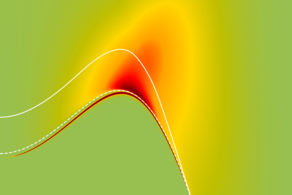New chirping techniques for excitation of quantum dots
- Reiter

Typically, a laser pulse is characterized by a single frequency, giving it its colour. In a chirped laser pulse, the frequency of the laser pulse changes during the pulse, either ranging from high to low or from low to high frequencies. Using chirped laser pulses to excite quantum dots has the advantage that small variation in the pulse parameters do not influence the inversion probability.
Generating chirped laser pulses in the lab can be done in various way. In this publication we show that we can use chirped fiber Bragg gratings (CFBGs) to generate chirped laser pulses. The CFBGs are very compact devices compared to other methods to generated chirped laser pulses, such as grating couplers. We demonstrate that the excitation of the quantum dot with the CFBGs is efficient and agrees excellently with theoretical predictions.
The paper results from our collaboration with the Photonics group from Innsbruck and the Rastelli group in Linz.







